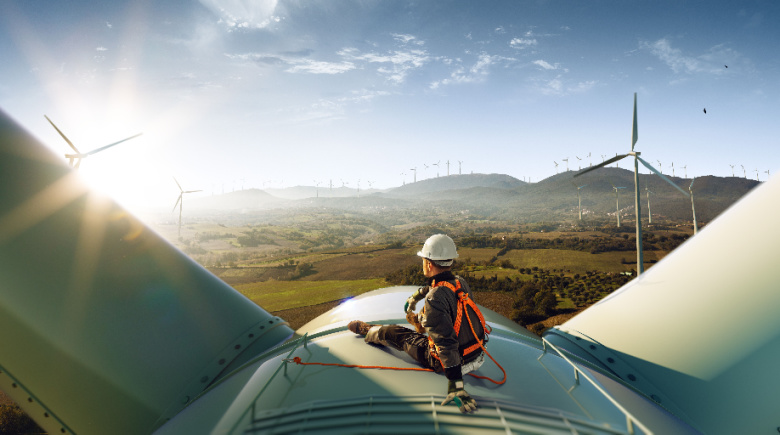When you think of wind energy in a historical setting, you might conjure up sailing vessels and windmills. Humans have harnessed the power of wind for a long time. That is not, however, the modern definition of wind energy. It involves harnessing the power of wind to produce electricity.
The electricity is produced on wind farms to maximize the output and minimize the costs. These modern windmills have propellers that are turned by the wind. This eventually leads to the rotor of a generator that produces the valuable electricity. Some of these wind farms cover a large expanse of land.
Wind energy is one of the clean energy sources being utilized today to replace fossil fuels. It has many advantages. Energysage is a website that discusses the pros and cons of this type of energy. One of the greatest selling points is the fact that wind is free. It is also abundant. While it is not always windy, most days will produce a substantial amount of wind. Free and abundant is hard to beat as an energy source.
Remember that the wind will not wear out. The wind turbine will have to be replaced at some time in the future, but there will always be wind. It will never run out. Wind is renewable and inexpensive.
Other points to consider involve land use. Wind farms are a very effective and productive use of land. In some cases, this is the best and highest use of the land. As will be discussed later, most wind farms are located in remote places where land is just not that valuable or expensive. Some wind farms are even placed offshore to capture the wind from the ocean or sea.
It is relatively inexpensive to operate a wind farm. Once the initial investment has been made in the wind turbines, then there is only occasional maintenance. The propellors just keep turning and generating that valuable electricity.
Another consideration that makes wind energy valuable is job creation. The building of the wind farm requires skilled workers. The more farms that are created, the more jobs that appear. There is an article about careers in wind energy on a page maintained by the U.S. Bureau of Labor Statistics. The agency estimates that about 85,000 Americans currently work in the wind energy field.
Jobs are found in the manufacture of the wind turbines. They are complex pieces of equipment that require skilled workers to produce them. The turbines are employed in a large-scale project which involves workers to develop that system. There are numerous considerations in creating that large wind farm. These are skilled occupations that are good and high paying jobs.
Finally, although wind turbines require little monitoring once in place, there are jobs to repair and keep running these structures. The jobs involve climbing up and down ladders on the side of the wind turbine. There is preventive and actual maintenance to be performed.
When considering the cons of wind energy, it must be noted that wind farms tend to be in remote locations. It takes a considerable amount of land. As noted earlier, this is usually land not valuable for other uses. That is another word for remote. This requires lengthy transmission lines to move the electricity to large users.
One of the major objections is the noise and environmental impact, especially on animals such as birds. If the wind farm is remote, then noise is less of a factor. However, the rotating propellors are a hazard to birds and anything else that flies.
The problem is due to the fact that in order to get maximum wind, the blades must be high enough to capture the wind. That leads to the problems with birds. From the environmental viewpoint, wind turbines can block scenic locations such as mountains, lakes, and other locales. This disadvantage is often cited when putting turbines over water.
An example of a large-scale wind farm was announced by the federal government in 2022. It would involve erecting wind turbines in the Gulf of Mexico. This is obviously a long term project that requires an enormous amount of planning and execution. There are two projects that are being considered.
One is off the coast of Galveston, Texas. It would cover over 500,000 acres. The farm would product enough power to run over 2 million homes. A second farm off the coast of Louisiana would produce power for almost 800,000 homes. Both of these projects have some controversy along with great potential to generate electricity.
An example of the intersection between fossil fuels and wind energy is the collaboration of ExxonMobil with the Wind Energy Institute of Canada. The end product are lubricants that are necessary for the proper functioning of wind turbines. These lubricants help minimize the friction involved when the turbines operate.
Lower friction leads to less maintenance and less down time for the turbines. That means they can produce more electricity. ExxonMobil has years of experience with lubricants. It is applying that expertise in developing the next generation of lubricants to make wind turbines work better.
The World Economic Forum considered the potential of wind energy. They believe it is a major part of the drive away from fossil fuels. They estimate the next five years will produce as much wind energy as the last twenty years. There are obstacles such as production of wind turbines. However, these problems are solvable for a world needing clean energy in the near and distant future.
Wind energy will not solve all of the future problems with producing clean energy. It is, however, an important component of the drive for clean energy. The future holds the reality of more and larger wind farms driven by more efficient wind turbines. The field is an exciting part of the future of clean energy.
When you think of wind energy in a historical setting, you might conjure up sailing vessels and windmills. Humans have harnessed the power of wind for a long time. That is not, however, the modern definition of wind energy. It involves harnessing the power of wind to produce electricity.
The electricity is produced on wind farms to maximize the output and minimize the costs. These modern windmills have propellers that are turned by the wind. This eventually leads to the rotor of a generator that produces the valuable electricity. Some of these wind farms cover a large expanse of land.
Wind energy is one of the clean energy sources being utilized today to replace fossil fuels. It has many advantages. Energysage is a website that discusses the pros and cons of this type of energy. One of the greatest selling points is the fact that wind is free. It is also abundant. While it is not always windy, most days will produce a substantial amount of wind. Free and abundant is hard to beat as an energy source.
Remember that the wind will not wear out. The wind turbine will have to be replaced at some time in the future, but there will always be wind. It will never run out. Wind is renewable and inexpensive.
Other points to consider involve land use. Wind farms are a very effective and productive use of land. In some cases, this is the best and highest use of the land. As will be discussed later, most wind farms are located in remote places where land is just not that valuable or expensive. Some wind farms are even placed offshore to capture the wind from the ocean or sea.
It is relatively inexpensive to operate a wind farm. Once the initial investment has been made in the wind turbines, then there is only occasional maintenance. The propellors just keep turning and generating that valuable electricity.
Another consideration that makes wind energy valuable is job creation. The building of the wind farm requires skilled workers. The more farms that are created, the more jobs that appear. There is an article about careers in wind energy on a page maintained by the U.S. Bureau of Labor Statistics. The agency estimates that about 85,000 Americans currently work in the wind energy field.
Jobs are found in the manufacture of the wind turbines. They are complex pieces of equipment that require skilled workers to produce them. The turbines are employed in a large-scale project which involves workers to develop that system. There are numerous considerations in creating that large wind farm. These are skilled occupations that are good and high paying jobs.
Finally, although wind turbines require little monitoring once in place, there are jobs to repair and keep running these structures. The jobs involve climbing up and down ladders on the side of the wind turbine. There is preventive and actual maintenance to be performed.
When considering the cons of wind energy, it must be noted that wind farms tend to be in remote locations. It takes a considerable amount of land. As noted earlier, this is usually land not valuable for other uses. That is another word for remote. This requires lengthy transmission lines to move the electricity to large users.
One of the major objections is the noise and environmental impact, especially on animals such as birds. If the wind farm is remote, then noise is less of a factor. However, the rotating propellors are a hazard to birds and anything else that flies.
The problem is due to the fact that in order to get maximum wind, the blades must be high enough to capture the wind. That leads to the problems with birds. From the environmental viewpoint, wind turbines can block scenic locations such as mountains, lakes, and other locales. This disadvantage is often cited when putting turbines over water.
An example of a large-scale wind farm was announced by the federal government in 2022. It would involve erecting wind turbines in the Gulf of Mexico. This is obviously a long term project that requires an enormous amount of planning and execution. There are two projects that are being considered.
One is off the coast of Galveston, Texas. It would cover over 500,000 acres. The farm would product enough power to run over 2 million homes. A second farm off the coast of Louisiana would produce power for almost 800,000 homes. Both of these projects have some controversy along with great potential to generate electricity.
An example of the intersection between fossil fuels and wind energy is the collaboration of ExxonMobil with the Wind Energy Institute of Canada. The end product are lubricants that are necessary for the proper functioning of wind turbines. These lubricants help minimize the friction involved when the turbines operate.
Lower friction leads to less maintenance and less down time for the turbines. That means they can produce more electricity. ExxonMobil has years of experience with lubricants. It is applying that expertise in developing the next generation of lubricants to make wind turbines work better.
The World Economic Forum considered the potential of wind energy. They believe it is a major part of the drive away from fossil fuels. They estimate the next five years will produce as much wind energy as the last twenty years. There are obstacles such as production of wind turbines. However, these problems are solvable for a world needing clean energy in the near and distant future.
Wind energy will not solve all of the future problems with producing clean energy. It is, however, an important component of the drive for clean energy. The future holds the reality of more and larger wind farms driven by more efficient wind turbines. The field is an exciting part of the future of clean energy.



